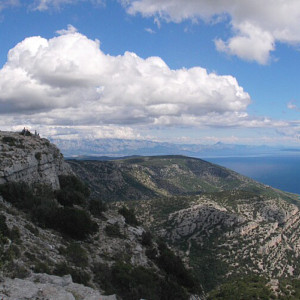In late August 2014, our customer Pierre went backpacking to Croatia or more precisely to Dalmatia.
He started his journey in Karlsruhe and his goal was to reach Zadar and then to travel along the coast and on to the islands to do some island hopping and then do a little hiking through inland Croatia. Pierre travelled mainly by bus and made a stopover in Zagreb before heading back home.
Pierre’s travelling companions were our durable 4 Continents 85 10 rucksack for backpackers, along with the trekking tent Trek It Easy for inexpensive stays at campsites, and the invisible money belt Money Safe.
In the report below, you can read all about Pierre’s experiences as a backpacker in Croatia, how he got on with camping and how he feels about the trip now. We hope you enjoy reading it!
The Outdoorer team would like to say thank you for the great report and the fantastic photos.
Zadar and Nin ─ start of the Dalmatia tour
My tour of Croatia began at Karlsruhe/Baden-Baden airport. From there I flew with a well-known low cost airline to Zadar.
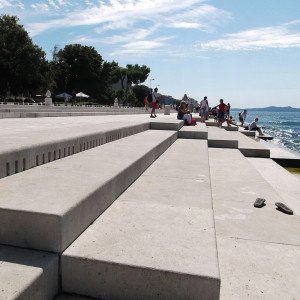 I was very impressed with Zadar. I’ve been around a number of cities, but I’ve never seen an “all-white” city, or at least not been aware of it. By this I mean that all the streets (in the centre) were made of bright paving stones (limestone). This made the city seem fresh, but also created a nostalgic atmosphere. Architecturally, the city has a lot to offer and must be an El Dorado for art historians. There are so many beautiful buildings from all sorts of eras.
I was very impressed with Zadar. I’ve been around a number of cities, but I’ve never seen an “all-white” city, or at least not been aware of it. By this I mean that all the streets (in the centre) were made of bright paving stones (limestone). This made the city seem fresh, but also created a nostalgic atmosphere. Architecturally, the city has a lot to offer and must be an El Dorado for art historians. There are so many beautiful buildings from all sorts of eras.
Zadar is home to a monument which is unique in the world – the Sea Organ. Underneath the promenade, there are cavities into which the water flows. Due to the resulting air pressure, sounds are produced in 35 organ pipes. The openings are visible in the soil. Under the steps, there are valves which suck in new air as the water flows out. Fascinating! Also on the promenade, you can look at the „Greeting to the Sun“. This is an integrated solar panel in the ground.
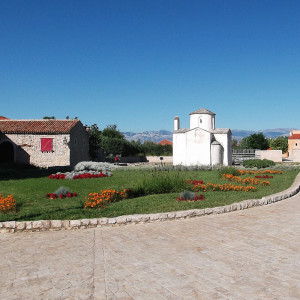 From Zadar we went towards Nin. This is a small village on an island that is connected to the mainland by only two bridges. The special thing about Nin is that the world’s smallest cathedral stands here – the cross-domed Sveti Kriz church. Built in the Byzantine style, the cathedral is visually nothing to write home about. Beach lovers, however, can enjoy themselves in Niner Bay. This is mainly for families with children, because there is a flat sandy beach and the water is only shallow. In addition, there is the (allegedly) famous Niner mud, which is widely used for beauty masks and cures.
From Zadar we went towards Nin. This is a small village on an island that is connected to the mainland by only two bridges. The special thing about Nin is that the world’s smallest cathedral stands here – the cross-domed Sveti Kriz church. Built in the Byzantine style, the cathedral is visually nothing to write home about. Beach lovers, however, can enjoy themselves in Niner Bay. This is mainly for families with children, because there is a flat sandy beach and the water is only shallow. In addition, there is the (allegedly) famous Niner mud, which is widely used for beauty masks and cures.
Getting there:
You can drive from Zadar airport and there are buses coordinated with flight arrivals (NB: if the driver thinks the bus is full, it will leave sooner than is stated on the timetable!). The bus takes about 20 minutes and costs 25 kuna (about € 3.10). From Autobusni Kolodvor (bus station) there are buses to and from Nin which run about once an hour in each direction. The journey takes about 30 minutes and costs 17 KN (about € 2.20).
Accommodation:
Apartment Tara Zadar. This is centrally located and close to the beach. It is like in a shared apartment. There are five bedrooms, a kitchen, a bathroom, a toilet. Paid: 156 KN/night (about € 20.00 euros). For the location and price, the accommodation was really good.
Paklenica National Park ─ a paradise for climbing and hiking in Croatia
 The next stop in my Croatia trip was Paklenica National Park, located to the north of Zadar. This was the location for some scenes from the legendary Winnetou films from the 1960s. The Velika and Mala Paklenica canyons are located in the National Park. The bedrock is limestone, in which there is normally only a subterranean drain (a so-called. karst). The peculiarity of these canyons, with their gleaming white cliffs, is that there is a surface runoff, which creates a stream. It is the surface runoff which created these deep, impressive gorges. In addition, there is a cave with stalactites, which can be visited. Climbers and hikers both come to this park at their own expense. There are already many anchored routes on the rock walls of the canyons. Since these are made of firmer Triassic limestone, they can easily be used for climbing.
The next stop in my Croatia trip was Paklenica National Park, located to the north of Zadar. This was the location for some scenes from the legendary Winnetou films from the 1960s. The Velika and Mala Paklenica canyons are located in the National Park. The bedrock is limestone, in which there is normally only a subterranean drain (a so-called. karst). The peculiarity of these canyons, with their gleaming white cliffs, is that there is a surface runoff, which creates a stream. It is the surface runoff which created these deep, impressive gorges. In addition, there is a cave with stalactites, which can be visited. Climbers and hikers both come to this park at their own expense. There are already many anchored routes on the rock walls of the canyons. Since these are made of firmer Triassic limestone, they can easily be used for climbing.
Getting there:
Starigrad-Paklenica is served by essentially all the buses, which run north/south along the coast. The trip from Zadar to Starigrad costs 28 KN (about € 3.70). Some bus companies require an extra ticket (e.g. Autotrans 10 kuna, about € 1.30) for luggage.
Accommodation:
I opted for the campsite „Camp Marko“. This is right on the road to the NP Paklenica (there is a road but don’t drive it at night!). At the campsite there are around about 20 plots at most. The price includes access to a kitchen with stove and a dining/common room. For one night I paid € 7.00 (or 100 KN/2 nights). I can only recommend it. It’s very cheap and comfortable and has nice owners.
Šibenik ─ wonderful views from the fortress Sv. Ana
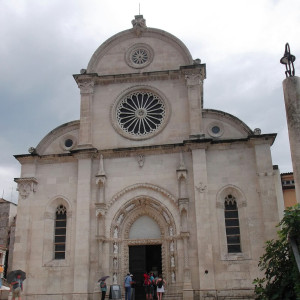 A few steps from Šibenik bus station, towards the waterfront of the estuary of the river Krka (which might make you think you were seeing the sea and which in a way you would be because rising sea levels have meant that seawater has found its way there), you can already see one of the most significant monuments Šibenik – the fortress Sv. Ana. This stands on a high point in the old town. From that height you have a wonderful view of Šibenik, the Mediterranean Sea and the offshore islands. In Šibenik there are a total of three upstream fortresses and an urban one.
A few steps from Šibenik bus station, towards the waterfront of the estuary of the river Krka (which might make you think you were seeing the sea and which in a way you would be because rising sea levels have meant that seawater has found its way there), you can already see one of the most significant monuments Šibenik – the fortress Sv. Ana. This stands on a high point in the old town. From that height you have a wonderful view of Šibenik, the Mediterranean Sea and the offshore islands. In Šibenik there are a total of three upstream fortresses and an urban one.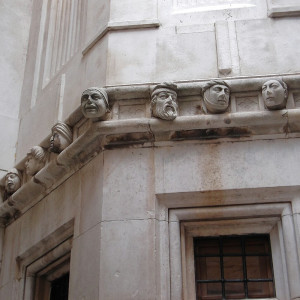
For culture vultures, the most important monument in Šibenik is the Sv. Jakob cathedral, which has been listed as a UNESCO World Heritage Site since 2000. The 74 stone portraits attached to the frieze around the choir are particularly fascinating.
Getting there:
There are frequent buses to Šibenik from Starigrad, as well as from all other parts of the country.
Accommodation:
None, because in transit.
Krka National Park ─ many small waterfalls along the trails
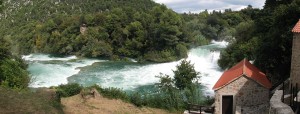 The next stop on my backpacking tour of Croatia was the Krka National Park. It is characterized by its many waterfalls. The National Park is highly recommended for hiking in Croatia. There are three entrances to the National Park. I decided to use the one by Lozovac. The entry by Skradin ought to be very romantic because from there you go by boat to the waterfalls. The main attraction in the Krka National Park is Skradinski buk. This is a travertine cascade system and the one in the national park is the largest of its kind. You will pass many small waterfalls on the trails go there. It’s all very impressive, but also very touristy – especially the prices. In the park, in addition to the regular tourist shops, there are saleswomen who sell nuts, figs and other fruits. Based on the purchase I made, I’d say their prices are exorbitant (e.g. a handful of figs is about € 5.00, I have paid the same for almost 2 kg in the market in Šibenik!).
The next stop on my backpacking tour of Croatia was the Krka National Park. It is characterized by its many waterfalls. The National Park is highly recommended for hiking in Croatia. There are three entrances to the National Park. I decided to use the one by Lozovac. The entry by Skradin ought to be very romantic because from there you go by boat to the waterfalls. The main attraction in the Krka National Park is Skradinski buk. This is a travertine cascade system and the one in the national park is the largest of its kind. You will pass many small waterfalls on the trails go there. It’s all very impressive, but also very touristy – especially the prices. In the park, in addition to the regular tourist shops, there are saleswomen who sell nuts, figs and other fruits. Based on the purchase I made, I’d say their prices are exorbitant (e.g. a handful of figs is about € 5.00, I have paid the same for almost 2 kg in the market in Šibenik!).
From Šibenik regular buses towards Lozovac/Skradin, also stop at Camp Krka. The fare is 15 KN (about € 2.00). From the Camp to the NP is about a 30-minute walk… From Skradin there are boats go in the direction of Krka Lozovac.
Accommodation:
Camp Krka. Very nice, affordable campsite (50 KN/night, about € 6.50). Family-run campsite with breakfast served in the morning for 35 KN (€ 4.60) and an à la carte restaurant in the evening. They make very good food, but there are chips with everything.
Trogir ─ another highlight of my backpacking trip through Croatia
I continued further south on my travels in Dalmatia and made my next stop in Trogir. The first thing I noticed when I got off the bus is that the climate here is Mediterranean. There were also palm trees everywhere, which did not exist previously. Trogir is situated on an island and is only connected to the mainland by a single bridge (there is, however, a second footbridge). Trogir is very small, but still has a lot to offer. For example, scenes from the Winnetou films were also shot here; Trogir was the film location for Santa Fe.
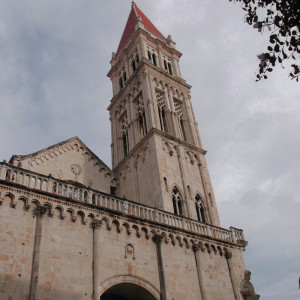 An archway, with a Gothic figure of the patron saint Sv. Ivan, marks the entrance to the old town. Just beyond is the Sv. Lovro Cathedral. The cathedral’s Romanesque portal is very impressive. Right and left of the door arch, there are two figures which represent Adam and Eve.
An archway, with a Gothic figure of the patron saint Sv. Ivan, marks the entrance to the old town. Just beyond is the Sv. Lovro Cathedral. The cathedral’s Romanesque portal is very impressive. Right and left of the door arch, there are two figures which represent Adam and Eve. 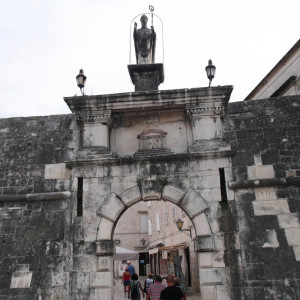 Furthermore, the upper part of the door frame represents the Biblical Heaven while the lower part represents the secular world. The door frame consists of three rows of columns. The exterior is fitted with figures of saints and apostles, in the middle there is the life of the people in Medieval times and in the interior demons and mythical creatures are depicted.
Furthermore, the upper part of the door frame represents the Biblical Heaven while the lower part represents the secular world. The door frame consists of three rows of columns. The exterior is fitted with figures of saints and apostles, in the middle there is the life of the people in Medieval times and in the interior demons and mythical creatures are depicted.
At the end of the promenade there is the impressive Kamerlengo Fortress, which was built by the Venetians after they conquered Trogir to protect the armed forces. By the time I left I was absolutely certain that Trogir had more than earned its status as a UNESCO World Heritage Site (since 1997)!
Getting there:
All the buses which run along the coast stop here (Šibenik – Trogir 51 KN + 10 KN luggage, about € 8.00).
Accommodation:
In the neighbouring town Seget Donji in Kamp Seget. 77 KN / night (about € 10.10). There is a very nice private beach, which is heaped with coarse sand/small pebble. Rather quiet camp-site with a lot of pensioners! Avoid the pitches in the upper part because there is a busy road.
Split ─ one of the most impressive cities in my Dalmatia tour
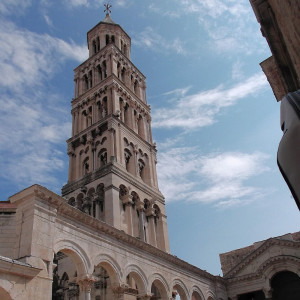 Split was not only one of the finest cities on my trip; it is one of the finest cities I have ever seen. It’s impressive how the Diocletian’s Palace extends a full of 215 x 180 meters through the entire old town. The highlight of this is the peristyle – an open throne room. Next to this, there is the Dominus Cathedral with Egyptian Sphinx and Corinthian columns at the entrance. Simply amazing! Similarly, the other buildings and the seaside promenade are wonderful – again the town is full of the white limestone, which first caught my eye in Zadar. The flair of the city is hard to put into words – it is best to look at yourself. Although Split is flooded with tourists, it is still a must-see!
Split was not only one of the finest cities on my trip; it is one of the finest cities I have ever seen. It’s impressive how the Diocletian’s Palace extends a full of 215 x 180 meters through the entire old town. The highlight of this is the peristyle – an open throne room. Next to this, there is the Dominus Cathedral with Egyptian Sphinx and Corinthian columns at the entrance. Simply amazing! Similarly, the other buildings and the seaside promenade are wonderful – again the town is full of the white limestone, which first caught my eye in Zadar. The flair of the city is hard to put into words – it is best to look at yourself. Although Split is flooded with tourists, it is still a must-see!
Getting there:
There are buses from pretty much anywhere (even from Germany/Austria!!). Although Split also has a train station, trains to other cities are very limited. I came from Trogir with the number 37 bus (21 KN, approximately € 2.80, this cheaper than with the long-distance buses). In addition, there are ferries to/from other islands/cities/countries.
Accommodation:
None, because in transit. Split has no camp-site anyway. Just an expensive one on the outskirts.
Omiš and Cetina canyon ─ a unique landscape for hiking in Croatia
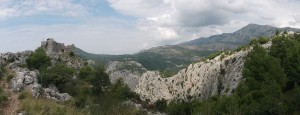 I was not expecting much from my backpacking break in Omiš. I only planned to spend a maximum of two nights there. Once there, however, I was immediately overwhelmed by the surroundings. You can’t expect much from the town of Omiš either. There is nothing special about it. However, the site is bordered by the Mosor Mountains and is located at the exit from the Cetina canyon, creating a unique landscape. In the end I moved on after four days with a heavy heart. Firstly I took in Stari-Grad castle. The castle is situated on a hilltop above the city. The way to the top was more strenuous than I expected and is not without danger. It was lucky I had my walking shoes, because the road was really no different to the moderate routes in the Alps and some parts of it were definitely difficult! A tip – there are two ways to get there. I recommend the route from the (old) town. This is longer but a lot nicer than the route through the Cetina Canyon (hardworking hikers can reach the plateau from more distant places).
I was not expecting much from my backpacking break in Omiš. I only planned to spend a maximum of two nights there. Once there, however, I was immediately overwhelmed by the surroundings. You can’t expect much from the town of Omiš either. There is nothing special about it. However, the site is bordered by the Mosor Mountains and is located at the exit from the Cetina canyon, creating a unique landscape. In the end I moved on after four days with a heavy heart. Firstly I took in Stari-Grad castle. The castle is situated on a hilltop above the city. The way to the top was more strenuous than I expected and is not without danger. It was lucky I had my walking shoes, because the road was really no different to the moderate routes in the Alps and some parts of it were definitely difficult! A tip – there are two ways to get there. I recommend the route from the (old) town. This is longer but a lot nicer than the route through the Cetina Canyon (hardworking hikers can reach the plateau from more distant places).
 Once up there, the view is simply breath-taking. On the ocean side you can look at the Mediterranean Sea with the barrier island of Brač, the town of Omiš and the mouth of the Cetina Gorge and along the Adriatic coast. Facing inland you can take in the Mosor Mountains and the Cetina Canyon. It’s an amazing view!
Once up there, the view is simply breath-taking. On the ocean side you can look at the Mediterranean Sea with the barrier island of Brač, the town of Omiš and the mouth of the Cetina Gorge and along the Adriatic coast. Facing inland you can take in the Mosor Mountains and the Cetina Canyon. It’s an amazing view!
 The next day I went walking in the Cetina Gorge. For a short time you can follow a trail there. Along the way, there are information panels about the flora, fauna and geology. As the trail leads to the summit of a mountain, there are regular lookout points. From the summit the view was amazing. To the left, there was the Cetina Gorge, then the narrowness of the Cetina canyon just before its mouth, behind it lay the Mediterranean Sea with the barrier island of Brač and to the right the village of Zakučac. Also to the right you could see a river. This was the part of the Cetina, which mostly travels its way underground into a karst system. Shortly before its mouth, this part of the Cetina comes to light again.
The next day I went walking in the Cetina Gorge. For a short time you can follow a trail there. Along the way, there are information panels about the flora, fauna and geology. As the trail leads to the summit of a mountain, there are regular lookout points. From the summit the view was amazing. To the left, there was the Cetina Gorge, then the narrowness of the Cetina canyon just before its mouth, behind it lay the Mediterranean Sea with the barrier island of Brač and to the right the village of Zakučac. Also to the right you could see a river. This was the part of the Cetina, which mostly travels its way underground into a karst system. Shortly before its mouth, this part of the Cetina comes to light again.
Near Omiš there are plenty of other hiking opportunities. For example, I was recommended the walk to a chapel above the village Zakučac. Unfortunately, I had to continue my journey.
Getting there:
On the one hand all the buses which run from Split to Makarska stop here. From Split you can also take the number 60 bus (21 KN approximately € 2.70). NB: the city buses have other „Autobusni kolodvor“. The long-distance buses are in the port area, the city buses just outside, they also stop around the old town.
Accommodation:
Autokamp Lisicina, 48 KN/night (about € 6.30). But you need to be a cat lover. A whole family of cats has made its home in the camp-site. The owners, who live in the house in the grounds, tolerate the cats. They feed them, but do not let them into the house. It can get annoying when the cats keep coming up to you wanting food.
Makarska ─ crystal clear water with some almost deserted beaches
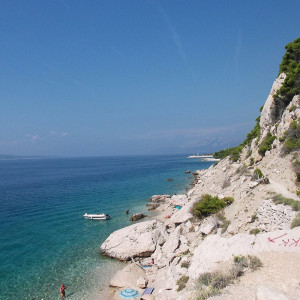 In and of itself the city of Makarska does not have much to offer backpackers – there are no special attractions or buildings. Accordingly, you’ll hardly find any sight-seeing tourists travelling there. It was really amazing because at noon in the centre of Makarska you can hardly see a soul. Makarska Riviera, however, has some of the most beautiful beaches anywhere – and the beaches are completely uncrowded.
In and of itself the city of Makarska does not have much to offer backpackers – there are no special attractions or buildings. Accordingly, you’ll hardly find any sight-seeing tourists travelling there. It was really amazing because at noon in the centre of Makarska you can hardly see a soul. Makarska Riviera, however, has some of the most beautiful beaches anywhere – and the beaches are completely uncrowded.
The coast around Makarska consists partly of bright and fine gravel and partly of rocky coves. Just outside the town you can even find bays, which you can claim all to yourself. The water is crystal clear and mountain range Biokovo extends behind it. It’s just fantastic!
Getting there:
From Split (and also Dubrovnik) there are regular buses along the coast. These stop along the way in every city/tourist spot.
Accommodation:
None, because in transit.
Island of Brač ─ fantastic view from Vidova Gora to the mainland and the many islands
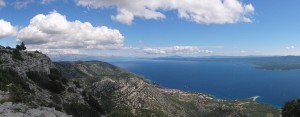 In Bol, in the southern part of the island of Brač, you will find the Zlatni Rat – the Golden Horn. This is one of the most famous beaches, as it sticks out into the sea like a horn and what’s more its curves change according to the motion of the waves. In reality, the beach is not very nice. Above all, it’s overcrowded even in the off-season. However, you can find pleasant places for bathing along the waterfront because there is nothing wrong with the sea itself. The water is crystal clear.
In Bol, in the southern part of the island of Brač, you will find the Zlatni Rat – the Golden Horn. This is one of the most famous beaches, as it sticks out into the sea like a horn and what’s more its curves change according to the motion of the waves. In reality, the beach is not very nice. Above all, it’s overcrowded even in the off-season. However, you can find pleasant places for bathing along the waterfront because there is nothing wrong with the sea itself. The water is crystal clear.
I was especially taken with the Vidova gora – a viewpoint at Bol. At 780 metres above sea level, Vidova gora is the highest point in the Croatian Adriatic. The view from there surpassed anything I had ever seen so far is still unequalled. The interplay of Biokovo Mountain on the mainland, with the many islands and their peaks and the Mediterranean Sea was just gorgeous and it certainly helped that there was a lot of sunshine. Above all, if you stand on the coast below, you do not expect such an amazingly breath-taking view. It is worthwhile going to the island of Brač if only because of Vidova gora. It’s an absolute must-see!
Getting there:
From Makarska ferries go to Sumartin (island of Brač), this costs 33 KN without cars (approx. € 4.30). From Sumartin there are buses to Bol.
Accommodation:
Kamp Mario, 65 KN/night. I do not know how this campsite got 3 stars. There may have been a bribe involved or they may just have awarded themselves the stars (though the official signs also show 3 stars!). None of the previous camp-sites had toilets and showers which were anywhere near as bad as this. The sinks had neither soap nor a way to dry your hands.
Hvar ─ island hopping to the most beautiful beaches in Dalmatia
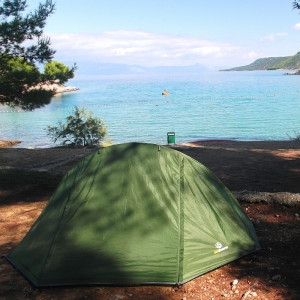 While I was camping in Dalmatia, the most beautiful beaches I found were on the island of Hvar. The water was crystal clear, the beach areas were not overcrowded and with the surrounding topography it was simply incredibly beautiful. Even the campsite in the unspectacular village Jelsa had a gorgeous private beach. My pitch was located only a few meters from the sea.
While I was camping in Dalmatia, the most beautiful beaches I found were on the island of Hvar. The water was crystal clear, the beach areas were not overcrowded and with the surrounding topography it was simply incredibly beautiful. Even the campsite in the unspectacular village Jelsa had a gorgeous private beach. My pitch was located only a few meters from the sea.
A beach vacation on the island of Hvar can be combined wonderfully with a city break in the town of Hvar. Unlike the towns of Jelsa and Stari Grad, Hvar (city) is well worth seeing. The highlight for me was the Španjola fortress on a hill overlooking the city. Its walls pull you in, even through the narrow streets of the mountain. The walk to the fortress is very worthwhile. 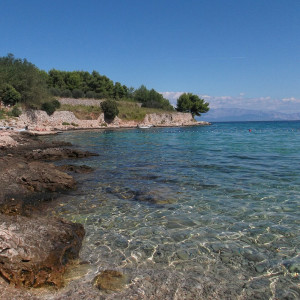 On one hand, you go through a „palace garden“ of a different kind (there are magnificent cactus along the way). On the other hand, from the hill there is a wonderful view of the Mediterranean Sea and a few small islands just off the coast, and the island of Vis in the distance.
On one hand, you go through a „palace garden“ of a different kind (there are magnificent cactus along the way). On the other hand, from the hill there is a wonderful view of the Mediterranean Sea and a few small islands just off the coast, and the island of Vis in the distance.
In the neatly-arranged town centre, there is the church of Sv. Stjepan with its massive bronze doors. These depict impressive portraits of the local Holy legends of the islands and scenes from the life of Jesus. Not far from the church, there is the first municipal theatre in Europe, which dates from the year 1612.
Getting there:
From Bol there is a daily catamaran to Jelsa. From Jelsa there are several buses a day to Hvar (city). The Bol-Jelsa ferry costs 35 KN (about € 4.70).
Accommodation:
Camping Accommodation Jelsa ─ Camp Mina. Men and women should be OK with taking a shower in the same space as the other sex, because there is only one room for it! The condition of the toilets and showers is a disaster. The toilets stink and they are not really clean. The location, however, is unbeatable. It is in its own beautiful, empty bay. Costs 63 KN/night (about € 8.50).
Accommodation Hvar (city) ─ since Hvar (city) has no camp-site near, I stayed in private accommodation. In the off-season there is no problem finding something on the day, quite the contrary, owners stand at the bus stations looking for tenants. I was very lucky to get a private room and for only 60 KN (about € 8.50), Hvar (city) is otherwise relatively expensive!
It was in Hvar that I ended my backpacking and camping trip through Dalmatia. On the way home I made a stop in Zagreb, the capital of Croatia.
Zagreb – a quiet and architecturally interesting city – well worth a visit on a trip to Croatia
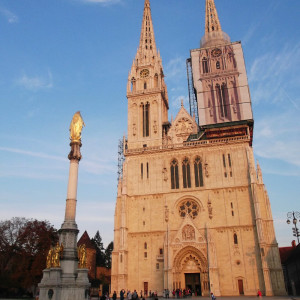 I was very surprized when I first saw Zagreb. The city is never mentioned when talking about potential city breaks. Why not? The city is wonderful. Even though Zagreb is both large and a capital city, the pace of life is actually very tranquil. It is not remotely hectic the way other major cities are. It is really very pleasant and the prices are amazingly good.
I was very surprized when I first saw Zagreb. The city is never mentioned when talking about potential city breaks. Why not? The city is wonderful. Even though Zagreb is both large and a capital city, the pace of life is actually very tranquil. It is not remotely hectic the way other major cities are. It is really very pleasant and the prices are amazingly good.
Architecturally, the city fascinated me greatly, especially the way it was divided. The old town, or the touristy part of the city, is divided into the Upper Town (Gornji Grad), which is located on a hill, and the Lower Town (Donji Grad). The special feature of the Lower Town is the rectangular arrangement of green spaces with architecture inside them, which thereby assumes the shape of a horseshoe, the so-called Green Horseshoe. In this horseshoe, architectural masterpieces have been built alongside lovingly designed and well-kept lawns.
Markov trg square is in the centre of the upper town. This is bounded by government buildings. Even here there is no trace of hustle or bustle to be felt. It seems like an ordinary residential area. For example, in the west of the square there is the Banski dvori (Banal-yard) – the seat of the Croatian Government and the Prime Minister. In front of it there stood only a single policeman!
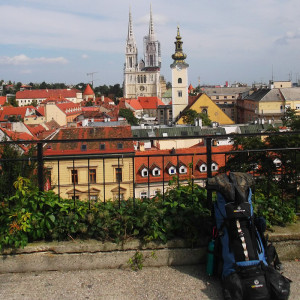 In the centre of this square, there stands the church of St. Mark. The extraordinary thing about it is that the bricks are made in Croatia’s national colours – red, white and blue. In addition, there are two coats of arms covering the south side of the roof. One coat of arms shows a trinity of the Kingdom of Croatia, Dalmatia and Slavonia. The other is that of the city of Zagreb.
In the centre of this square, there stands the church of St. Mark. The extraordinary thing about it is that the bricks are made in Croatia’s national colours – red, white and blue. In addition, there are two coats of arms covering the south side of the roof. One coat of arms shows a trinity of the Kingdom of Croatia, Dalmatia and Slavonia. The other is that of the city of Zagreb.
On the outskirts of the upper town, you can find Zagreb’s main attraction – The Assumption of the Blessed Virgin Mary Cathedral. This is currently being renovated with the result that a small part of the viewing area has disappeared. Outside the cathedral there is the “Fountain of the Virgin Mary with Angels”, which has no equal. At the top, there is a sculpture of the Mother of God. Under her there are four angels who embody the Christian virtues – faith, hope, innocence and humility. The gilded sculptures truly radiate in intense golden colour!
Getting there:
From Hvar (city) catamarans go to Split. The trip costs 55 KN (about € 7.60). Many buses go to Zagreb. The fare is 160 KN (about € 22.20). There is also a daily train to Zagreb. The ticket (with an IC) costs 260 KN (approximately € 36.00).
Accommodation:
The plan was actually to spend the night at the camp-site. However because this is very far out of town and is not exactly cheap at more than € 13.00 per night, I decided to look for a discount hostel (via smartphone app, it works flawlessly). I then ended up at the hostel Favela. It is like a large one-family house with a few private rooms and a common room. The rooms are nice and have relatively new furnishings. When I was there, it seemed to be not particularly clean, but it was still reasonable enough. Its location is a bit out of the way. You can walk to the city centre in about 25 minutes; the tram takes a few minutes and costs 10 KN (about € 3.60). I spent the night with a 6-person dormitory to myself for 100 KN /night (about € 13.50), WiFi was included.
Conclusion
In retrospect, I can say that this was a really great backpacking trip through Croatia. The equipment was robust, I have seen a lot and I know nothing happened. I am also happy to have braved this trip alone. I’ve had experiences that I would have certainly not have experienced with another person!

